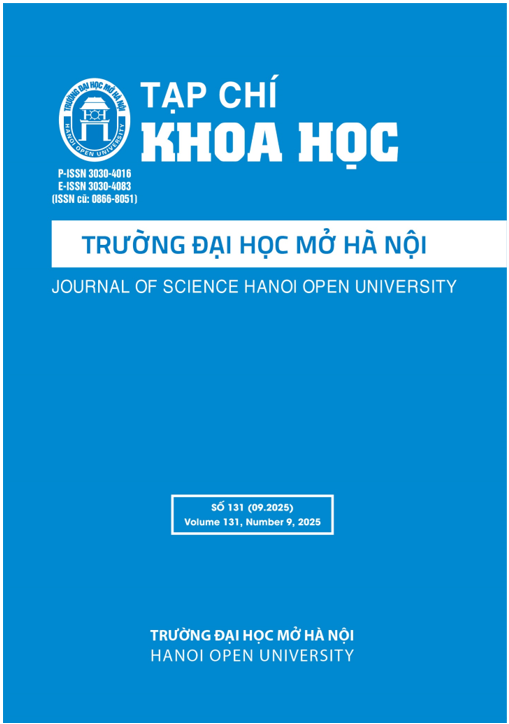CONSTRUCTIVIST TEACHING TO FOSTER CRITICAL THINKING IN GRADE 5 ENGLISH: A CASE STUDY AT THANH PHU PRIMARY SCHOOL
DOI:
https://doi.org/10.59266/houjs.2025.751Từ khóa:
constructivism, critical thinking, primary education, teaching strategies, case studyTóm tắt
This study investigates the role of constructivist teaching approaches in developing critical thinking skills among students at Thanh Phu Primary School. Constructivism emphasizes active student engagement, problem-solving, and experiential learning, which are essential for nurturing critical thinking. Through a qualitative case study method, data were collected using classroom observations, teacher interviews, and student work analysis. The findings revealed that when constructivist strategies such as collaborative learning, questioning techniques, and project-based activities were implemented, students demonstrated enhanced reasoning, analytical thinking, and reflective abilities. Teachers played a pivotal role in facilitating discussions and guiding learners to construct their own understanding. However, challenges such as limited resources and time constraints were also identified. This study highlights the effectiveness of constructivist pedagogy in fostering essential 21st-century skills in young learners and provides practical implications for primary school educators.
Tài liệu tham khảo
[1]. Boaler, J. (2002). Experiencing school mathematics: Traditional and reform approaches to teaching and their impact on student learning. Routledge.
[2]. Brooks, J. G., & Brooks, M. G. (1999). In search of understanding: The case for constructivist classrooms. ASCD.
[3]. Bruner, J. (1966). Toward a theory of instruction. Harvard University Press.
[4]. DeVries, R., & Kohlberg, L. (1987). Constructivist early education: Overview and comparison with other programs. National Association for the Education of Young Children.
[5]. Ennis, R. H. (1985). A logical basis for measuring critical thinking skills. Educational Leadership, 43(2), 44-48.
[6]. Ennis, R. H. (2018). Critical thinking across the curriculum: A vision. Topoi, 37(1), 165-184. https://doi.org/10.1007/ s11245-016-9401-4
[7]. Facione, P. A. (1990). Critical thinking: A statement of expert consensus for purposes of educational assessment and instruction (The Delphi Report). American Philosophical Association.
[8]. Fang, Z. (2020). Teaching reading and writing in the twenty-first century classroom: Constructivist perspectives. Springer.
[9]. Fosnot, C. T. (Ed.). (2013). Constructivism: Theory, perspectives, and practice (2nd ed.). Teachers College Press.
[10]. Nguyễn, T. H. (2019). Phát triển tư duy phản biện cho học sinh tiểu học thông qua hoạt động nhóm. Tạp chí Khoa học Trường Đại học Mở Hà Nội, 57(4), 45-52.
[11]. Nguyễn, T. H. (2023). Ứng dụng phương pháp kiến tạo trong dạy học nhằm nâng cao năng lực tư duy sáng tạo ở bậc tiểu học. Tạp chí Khoa học Trường Đại học Mở Hà Nội, 72(2), 33- 41.
[12]. Nguyễn, T. H. (2024). Bồi dưỡng kỹ năng phản biện cho học sinh tiểu học qua môn Tiếng Anh. Tạp chí Khoa học Trường Đại học Mở Hà Nội, 75(1), 60- 68.
[13]. Hammond, L. D. (2001). Powerful learning: What we know about teaching for understanding. Jossey-Bass.
[14]. Harlen, W., & Qualter, A. (2004). The teaching of science in primary schools (4th ed.). David Fulton Publishers.
[15]. Hein, G. E. (1991). Constructivist learning theory. CECA (International Committee of Museum Educators) Conference Proceedings, 1-15.
[16]. Le, M. A. (2024). Theme-based lessons to cultivate creativity competencies in primary education. Hue: National University Press.
[17]. Marlowe, B. A., & Page, M. L. (2005). Creating and sustaining the constructivist classroom. Corwin Press.
[18]. MOET. (2018). General education curriculum framework. Ministry of Education and Training, Vietnam.
[19]. Nguyen, T. H. (2019). Implementing critical thinking in primary moral education: Opportunities and challenges in Vietnam. Hanoi: Education Publishing House.
[20]. Palincsar, A. S. (1998). Social constructivist perspectives on teaching and learning. Annual Review of Psychology, 49(1), 345-375. https://doi. org/10.1146/annurev.psych.49.1.345
[21]. Pham, T. T. H., & Renshaw, P. (2013). How to enableAsian teachers to empower students to adopt student-centred learning. Australian Journal of Teacher Education, 38(11), 65-85. https://doi. org/10.14221/ajte.2013v38n11.4
[22]. Piaget, J. (1973). To understand is to invent: The future of education. Grossman Publishers.
[23]. Richardson, V. (2003). Constructivist pedagogy. Teachers College Record, 105(9), 1623-1640. https://doi.org/10.1046/j.1467-9620.2003.00303
[24]. Tam, M. (2000). Constructivism, instructional design, and technology: Implications for transforming distance learning. Educational Technology & Society, 3(2), 50-60.
[25]. Tobin, K., & Tippins, D. J. (1993). Constructivism as a referent for teaching and learning. In K. Tobin (Ed.), The practice of constructivism in science education (pp. 3-21). Lawrence Erlbaum Associates.
[26]. Tran, P. Q. (2023). Creative thinking tasks for primary students: Constructivist approaches in Vietnamese classrooms. Ho Chi Minh City: University of Pedagogy Press.
[27]. Vygotsky, L. S. (1978). Mind in society: The development of higher psychological processes. Harvard University Press.
[28]. von Glasersfeld, E. (1995). Radical constructivism: A way of knowing and learning. Falmer Press.
[29]. Wiggins, G. (1993). Assessing student performance: Exploring the purpose and limits of testing. Jossey-Bass.
[30]. Windschitl, M. (2002). Framing constructivism in practice as the negotiation of dilemmas. Review of Educational Research, 72(2), 131-175.
